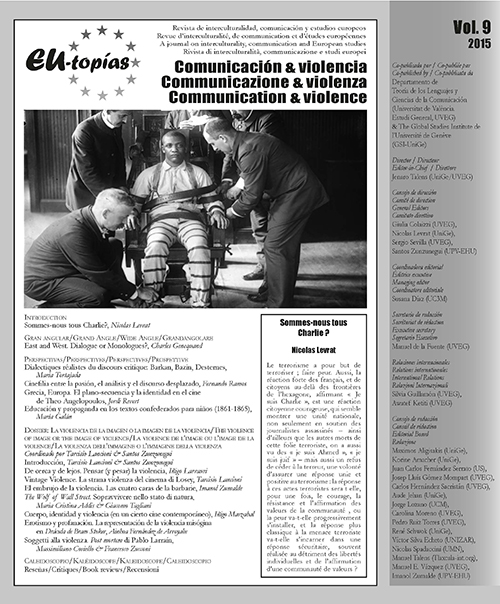Erotismo y profanación. La representación de la violencia misógina en Drácula de Bram Stoker
DOI:
https://doi.org/10.7203/eutopias.0.18754Keywords:
Sex and violence, misogyny, eroticism, sexual bestiality, decadent iconography, horror films Abstract
Abstract
Bram Stoker’s Dracula (1992) creatively re-interprets the two representations of violence in the original literary work: sexual bestiality, and the ritual of vampire death. This re-interpretation relies on the devices of postmodern cinema and the iconographic references of decadent painting like dark romanticism or symbolism. As a result, the eroticization of the beauty of the decadent eye transforms the extreme sadomasochistic violence that characterizes the sexual encounters between Lucy and the Vampire, Harker and the women-beasts in voluptuous scenes where the spectator’s scopophiliac pleasure is notably increased by postmodern cinema’s mechanisms of immersion inviting the viewers to submerge themselves in this universe of pleasure and pain. Also, in the representation of of the woman-beast’s execution a distance is mantained and there is pleasure in illustrating the tremendous brutality with which the beloved destroys the body of his dead fiancée, and establishes the civilizing order of Victorian society.
 Downloads
Downloads
 References
References
Austin, Thomas (2002), «“Gone with the Wind Plus Fangs”: Genre, Taste and Distinction in the Assembly, Marketing and Reception of Bram Stoker’s Dracula», Steve Neale (ed.), Genre and Contemporary Hollywood, London: British Film Institute, pp. 282- 306.
Bignell, Jonathan (1996), «Spectacle and the Post- modern in Contemporary American Cinema», La Licorne, 36, pp. 161-180.
Bornay, Erika (1995), Las hijas de Lilith, Madrid: Cátedra. BuCCheri, Vincenzo (2000), Sguardi sul postmoderno: il cinema contemporaneo: questioni, scenari, letture, Milano: Isu Universitá Cattolica.
Company, Juan Miguel (1993), «La melancolía del vampiro, Bram Stoker’s Dracula», Archivos de la Filmoteca, 15, pp. 105-109.
DiJkstra, Bram (1994), Ídolos de perversidad. La imagen de la mujer en la cultura decimonónica, Madrid: Debate.
Dika, Vera (1995), «From Dracula – With Love», Barry K. Grant (ed.), Film Genre and Reader II, Austin: University of Texas Press, pp. 388-399.
Gubern, Román & Prat, Joan (1979), Las raíces del miedo. Antropología del cine de terror, Barcelona: Tusquets.
Jullier, Laurent (1997), L’écran post-moderne. Un cinéma de l’allusion et du feu d’artifice, Paris: L ́Harmattan.
Lecoteux, Claude (1999), Historie des vampires, autopsie d ́un mythe, Paris: Imago.
Lorente, Jesús Pedro (2001), «Amados cadáveres. Poética de la contemplación en el arte romántico», Begoña Torres González (ed.), Amor y muerte en el Romanticismo, Barcelona: Ministerio de Educación, Cultura y Deporte, pp. 79-102.
Paglia, Camille (2006), Sexual Personae. Arte y decadencia desde Nefertiti a Emily Dickinson, Madrid: Valdemar.
Pedraza, Pilar (2004), Espectra. Descenso a las criptas de la literatura y el cine, Madrid: Valdemar.
Praz, Mario (1999), La carne, la muerte y el diablo en la literatura romántica, Barcelona: Acantilado.
— (2002), Bellezza e bizzarria. Saggi scelti, Milano: Arnoldo Mondadori.
Vincendeau, Ginette (2001), Film/Literature/Heritage. A Sight and Sound Reader, London: British Film Institute.
Zunzunegui, Santos (1995), «Lo viejo y lo nuevo. La reinvención de la tradición cinematográfica en el final del siglo XX», Letras de Deusto, 25 (66), pp. 59-74.
Downloads
Published
How to Cite
-
Abstract471
-
PDF (Español)168
Issue
Section
License
![]()
The authors conserve the copyright. All content published in EU-topías. Journal of interculturality, Communication, and European Studies are subject to the license Creative Commons Attribution-NonCommercial-ShareAlike 4.0 license. The full text of the license can be found at <http://creativecommons.org/licenses/by-nc-sa/4.0>
They may be copied, used, disseminated, transmitted and publicly displayed, provided that:
- The authorship and original source of the publication is cited (journal, publisher and URL of the work).
- They are not used for commercial purposes.
- The existence and specifications of this license of use are mentioned.
It is the responsibility of the authors to obtain the necessary permissions for images that are subject to copyright.



